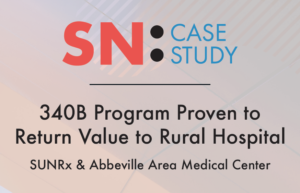
Solvent_CaseStudyAbbeville_19 (SunRx)
“The 340B program is really the lifeblood of the hospital. It provides substantial savings on prescription drugs for our patients and savings for the hospital that go right back into operations and expansion of services. We looked at other companies, but SUNRx came out as the shining star.”
Timothy Wren, CFO Abbeville Area Medical Center
Abbeville is a small, rural community that is rich in history, natural beauty and a near-perfect version of a town square. But lately it has struggled economically from the loss of manufacturing jobs, relocation of a railroad switching station and a growing population that is older and poorer than the state as a whole. About 27 percent of its citizens live below the poverty level. And when a town struggles economically, so do its institutions: schools, libraries and even hospitals.
Abbeville Area Medical Center (AAMC) has served this community faithfully for nearly 100 years, but during some of those more recent years, the hospital has operated in the red. Reorganizations and layoffs helped keep the doors open, but providing charity care of $1.5 million or more per year stretches resources to the limit. About four years ago, they partnered with SUNRx to implement a 340B discount drug program and began to see a turnaround. Chief Financial Officer Timothy Wren isn’t exaggerating when he calls the program “the lifeblood of the hospital.”
340B, which got started in 1992, is a federal program intended to make prescription drugs more affordable to low-income patients by requiring drug manufacturers to provide their products at reduced prices in order to be eligible for Medicaid. The program also provides a revenue stream to eligible healthcare facilities to encourage participation. SUNRx, an industry leader in managing 340B implementation and compliance, is an endorsed partner of Solvent Networks, a division of the South Carolina Hospital Association. The Solvent Networks seal of approval assures state hospitals that the company has been thoroughly vetted and offers the best possible financial arrangements.
The 340B program has helped AAMC better serve its low-income patients, supplement operating funds and even expand services.
“There’s significant overall savings to our patients that we can verify through SUNRx,” Wren said. “In 2017, it was more than $3.3 million, and this year will be about $400,000 more because we added two more contracted pharmacies to the network.”
For the hospital, last year’s revenues topped $600,000, and that figure is expected to grow to $1.1 million this year.
“As soon as the savings come in, they go right back into operations,” Wren said. But it’s not just about survival. Two years ago, they opened a $6 million clinic to house all providers on the hospital campus, and work is under way to install a new MRI unit.
“We’ve also expanded services in behavioral health, increased outreach to the community and employers, and launched an employee pharmacy, which will benefit our employees and help mitigate insurance costs in the long run,” he said. “None of that would have been possible without the 340B program.”
Patrick Colbert, director of account management at SUNRx, says the company assists hospitals and health systems of all sizes, “but the majority of our success has been in helping keep the doors open in rural areas.”
But, he cautions, implementing a 340B program isn’t quick or easy. The registration process happens only quarterly and the regulatory steps and approval process can take anywhere from four to nine months, even up to a year in some rare cases.
“Hospitals have to be active participants in the program,” he said. “There’s a lot of regulatory steps involved to ensure that a hospital is eligible for the program, and once you go live, maintaining compliances takes ongoing effort. But that’s where they can lean on their third-party administrator to help guide them, remind them and challenge them when necessary.”
While hospitals are ultimately responsible for maintaining compliance, SUNRx schedules regular phone meetings with participating hospitals to provide updates, focus on compliance, and avoid problems. “For example, a hospital must regularly submit their panel of providers who are eligible to write prescriptions. If there’s turnover among the providers and the hospital doesn’t submit an updated list to us, it could jeopardize their eligibility,” Colbert said. “So, during our regular meetings, that’s one question we always ask.”
Colbert says SUNRx offers 340B days/workshops to help hospital leaders understand the eligibility requirements and the kind of commitment required as well as the potential financial benefit. “These are educational programs, not sales pitches, because it is a complicated program,” he said.
Jeannie Capps, AAMC fiscal analyst, says SUNRx helps ease the administrative burden. “They help us with compliance, provide learning opportunities to keep us abreast of changes in the program, provide templates for policies and procedures and fully understand the audit process,” she said. “We have a monthly call with our representatives, and we utilize their software for tracking to be sure there’s no duplicate discounts or incorrect billing. If they find an outlier, they will work with us to get those dollars back. They’ve been fantastic to work with.”
“There’s a lot of regulatory red tape involved to ensure that a hospital is eligible for the 340B program, and maintaining compliances takes ongoing effort. But that’s where they can lean on their third-party administrator to guide them, remind them, challenge them when necessary.”
Patrick Colbert, Director, Account Management, SunRx
RETURN to related Pain Points Newsletter
